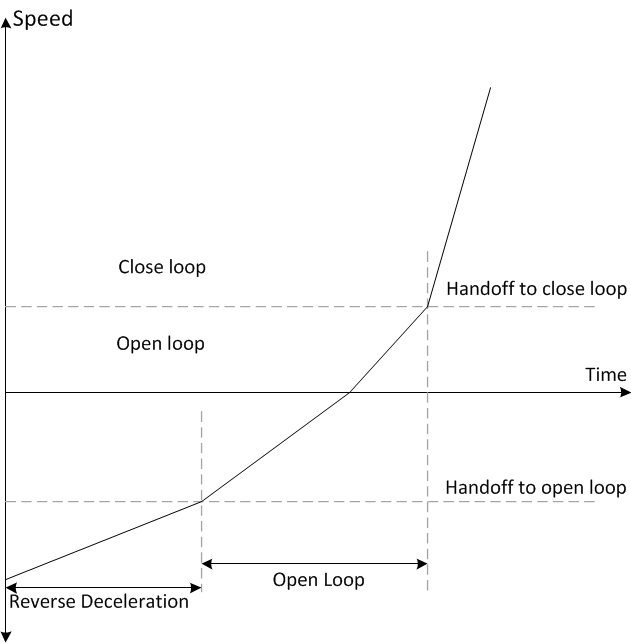SLLU335A August 2021 – January 2022 MCF8316A
- 1Revision History
- 2Introduction
- 3Essential Controls
-
4Basic Controls
- 4.1 Device and Pin Configuration
- 4.2 System Level Configuration
- 4.3
Control Configurations
- 4.3.1 Motor Parameter Estimation to Minimize Motor Parameter Variation Effects
- 4.3.2 Initial Speed Detection of the Motor for Reliable Motor Resynchronization
- 4.3.3 Unidirectional Motor Drive Detecting Backward Spin
- 4.3.4 Preventing Back Spin of Rotor During Startup
- 4.3.5 Faster Startup Timing
- 4.3.6 Gradual and Smooth Start up Motion
- 4.3.7 Improving Speed Regulation
- 4.3.8 Stopping Motor Quickly
- 4.3.9 Preventing Supply Voltage Overshoot During Motor Stop.
- 4.3.10 Protecting Against Rotor Lock or Stall Condition
- 4.3.11 Maximizing Thermal Efficiency and Increasing Thermal Performance
- 4.3.12 Mitigating Electromagnetic Interference (EMI)
- 4.3.13 Faster deceleration
4.3.3 Unidirectional Motor Drive Detecting Backward Spin
For applications that require spinning the motor in a specific direction, it is important to know if the motor is coasting or spinning in the direction opposite to the intended direction of spin. MCF8316A reverse drive function acts to reverse decelerate the motor through zero speed and to accelerate after changing direction until it transitions into closed loop as shown in Figure 4-7.
 Figure 4-7 Reverse Drive Function
Figure 4-7 Reverse Drive FunctionMCF8316A provides an option to apply brakes and stop the motor while the motor is coasting or spinning in reverse direction and then accelerate into closed loop after changing the direction.
In applications such as ceiling fans and pumps, it is required to spin the motor in specific direction for desired results. For such applications, it is recommended to follow the below recommendations.
Step 1: Enable ISD [ISD_EN]
Step 2: Enable Motor ISD Reverse drive [RVS_DR_EN]
Step 3: Enable reverse resynchronization [RESYNC_EN]
Step 4: Enable Active brake reverse drive [ACTIVE_BRAKE_REV_DRV_EN]
Step 5: Enter the Kp coefficient [ACTIVE_BRAKE_KP] and Ki coefficient [ACTIVE_BRAKE_KI] for Active braking loop. We recommend to start with Kp coefficient [ACTIVE_BRAKE_KP] as 700 and Ki coefficient [ACTIVE_BRAKE_KI] as 100.
Step 6: Set bus current limit during active braking [ACTIVE_BRAKE_CURRENT_LIMIT]
Follow the below recommendations if the motor fails to resynchronize in reverse direction.
Increase the reverse deceleration speed threshold to transition to open loop
Enable Open loop reverse drive configuration [REV_DRV_CONFIG]
Increase the Reverse Drive Open Loop Current Reference [REV_DRV_OPEN_LOOP_CURRENT]
Decrease open loop acceleration coefficient A1 and A2 during reverse drive
If the device triggers Lock current limit [LOCK_LIMIT], then increase the open loop current limit during speed reversal [REV_DRV_OPEN_LOOP_CURRENT]